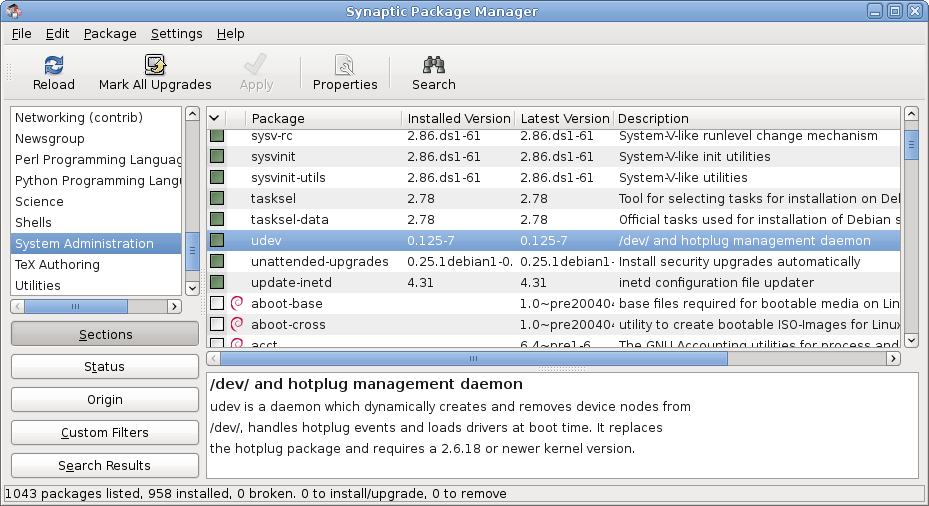|
Software Distributor
Software Distributor (SD) is the Hewlett-Packard company's name for their HP-UX software package management system. SD provides a set of tools for creating packages that will install software on a system running the HP-UX operating system. The packages can be grouped together into a software repository called a depot, and a server can be configured to host multiple depots for installation of software packages and even entire systems. SD was first available with release 10.0 of HP-UX in 1995. Since then it has undergone several enhancements and bug fixes, and now provides a reliable software installation tool. It uses a client-server arrangement to distribute software using a background daemon called '. This agent is started at boot time, and communicates using either the TCP or UDP protocols through RPC. The SD packages are normally stored and transmitted in compressed form, using either the gzip or compress programs. Commands The tools for performing SD operations are normally a ... [...More Info...] [...Related Items...] OR: [Wikipedia] [Google] [Baidu] |
Hewlett-Packard
The Hewlett-Packard Company, commonly shortened to Hewlett-Packard ( ) or HP, was an American multinational information technology company headquartered in Palo Alto, California. HP developed and provided a wide variety of hardware components, as well as software and related services to consumers, small and medium-sized businesses ( SMBs), and large enterprises, including customers in the government, health, and education sectors. The company was founded in a one-car garage in Palo Alto by Bill Hewlett and David Packard in 1939, and initially produced a line of electronic test and measurement equipment. The HP Garage at 367 Addison Avenue is now designated an official California Historical Landmark, and is marked with a plaque calling it the "Birthplace of ' Silicon Valley'". The company won its first big contract in 1938 to provide test and measurement instruments for Walt Disney's production of the animated film '' Fantasia'', which allowed Hewlett and Packard to forma ... [...More Info...] [...Related Items...] OR: [Wikipedia] [Google] [Baidu] |
HP-UX
HP-UX (from "Hewlett Packard Unix") is Hewlett Packard Enterprise's proprietary implementation of the Unix operating system, based on Unix System V (initially System III) and first released in 1984. Current versions support HPE Integrity Servers, based on Intel's Itanium architecture. Earlier versions of HP-UX supported the HP Integral PC and HP 9000 Series 200, 300, and 400 computer systems based on the Motorola 68000 series of processors, the HP 9000 Series 500 computers based on HP's proprietary FOCUS architecture, and later HP 9000 Series models based on HP's PA-RISC instruction set architecture. HP-UX was the first Unix to offer access control lists for file access permissions as an alternative to the standard Unix permissions system. HP-UX was also among the first Unix systems to include a built-in logical volume manager. HP has had a long partnership with Veritas Software, and uses VxFS as the primary file system. It is one of four commercial operati ... [...More Info...] [...Related Items...] OR: [Wikipedia] [Google] [Baidu] |
Package Management System
A package manager or package-management system is a collection of software tools that automates the process of installing, upgrading, configuring, and removing computer programs for a computer in a consistent manner. A package manager deals with ''packages'', distributions of software and data in archive files. Packages contain metadata, such as the software's name, description of its purpose, version number, vendor, checksum (preferably a cryptographic hash function), and a list of dependencies necessary for the software to run properly. Upon installation, metadata is stored in a local package database. Package managers typically maintain a database of software dependencies and version information to prevent software mismatches and missing prerequisites. They work closely with software repositories, binary repository managers, and app stores. Package managers are designed to eliminate the need for manual installs and updates. This can be particularly useful for large ent ... [...More Info...] [...Related Items...] OR: [Wikipedia] [Google] [Baidu] |
Software Repository
A software repository, or repo for short, is a storage location for software packages. Often a table of contents is also stored, along with metadata. A software repository is typically managed by source control or repository managers. Package managers allow automatically installing and updating repositories (sometimes called "packages"). Overview Many software publishers and other organizations maintain servers on the Internet for this purpose, either free of charge or for a subscription fee. Repositories may be solely for particular programs, such as CPAN for the Perl programming language, or for an entire operating system. Operators of such repositories typically provide a package management system, tools intended to search for, install and otherwise manipulate software packages from the repositories. For example, many Linux distributions use Advanced Packaging Tool (APT), commonly found in Debian based distributions, or yum found in Red Hat based distributions. There ... [...More Info...] [...Related Items...] OR: [Wikipedia] [Google] [Baidu] |
Daemon (computer Software)
In multitasking computer operating systems, a daemon ( or ) is a computer program that runs as a background process, rather than being under the direct control of an interactive user. Traditionally, the process names of a daemon end with the letter ''d'', for clarification that the process is in fact a daemon, and for differentiation between a daemon and a normal computer program. For example, is a daemon that implements system logging facility, and is a daemon that serves incoming SSH connections. In a Unix environment, the parent process of a daemon is often, but not always, the init process. A daemon is usually created either by a process forking a child process and then immediately exiting, thus causing init to adopt the child process, or by the init process directly launching the daemon. In addition, a daemon launched by forking and exiting typically must perform other operations, such as dissociating the process from any controlling terminal (tty). Such procedures ... [...More Info...] [...Related Items...] OR: [Wikipedia] [Google] [Baidu] |

